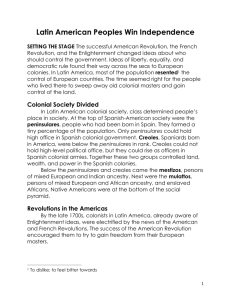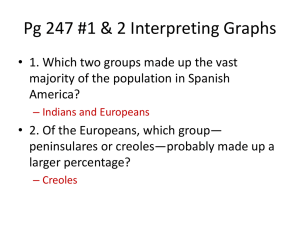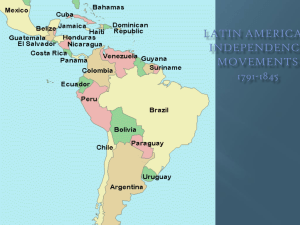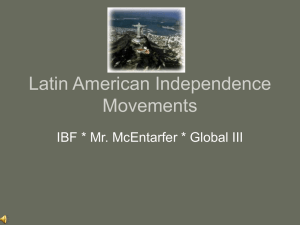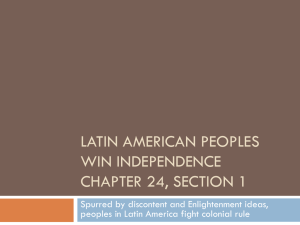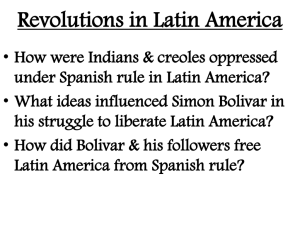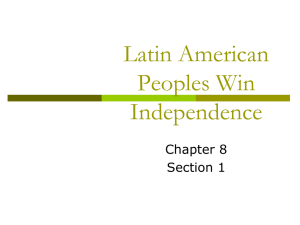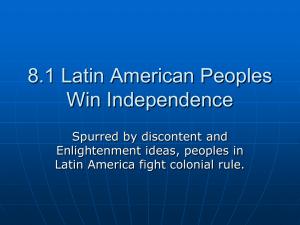Latin American Peoples Win Independence
advertisement
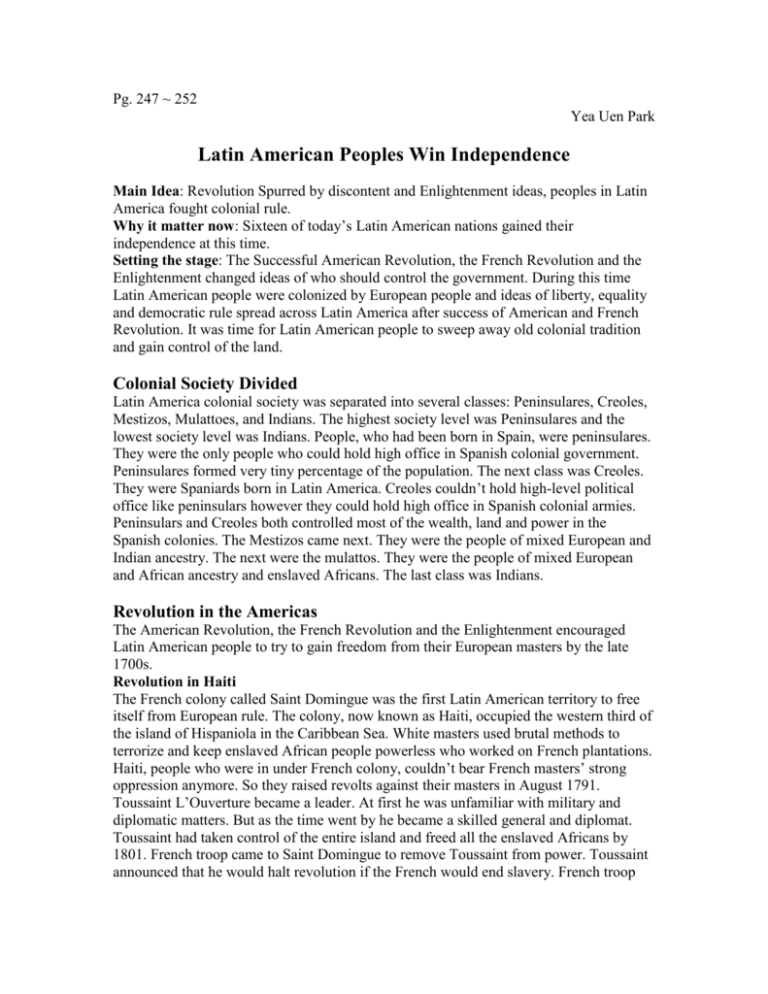
Pg. 247 ~ 252 Yea Uen Park Latin American Peoples Win Independence Main Idea: Revolution Spurred by discontent and Enlightenment ideas, peoples in Latin America fought colonial rule. Why it matter now: Sixteen of today’s Latin American nations gained their independence at this time. Setting the stage: The Successful American Revolution, the French Revolution and the Enlightenment changed ideas of who should control the government. During this time Latin American people were colonized by European people and ideas of liberty, equality and democratic rule spread across Latin America after success of American and French Revolution. It was time for Latin American people to sweep away old colonial tradition and gain control of the land. Colonial Society Divided Latin America colonial society was separated into several classes: Peninsulares, Creoles, Mestizos, Mulattoes, and Indians. The highest society level was Peninsulares and the lowest society level was Indians. People, who had been born in Spain, were peninsulares. They were the only people who could hold high office in Spanish colonial government. Peninsulares formed very tiny percentage of the population. The next class was Creoles. They were Spaniards born in Latin America. Creoles couldn’t hold high-level political office like peninsulars however they could hold high office in Spanish colonial armies. Peninsulars and Creoles both controlled most of the wealth, land and power in the Spanish colonies. The Mestizos came next. They were the people of mixed European and Indian ancestry. The next were the mulattos. They were the people of mixed European and African ancestry and enslaved Africans. The last class was Indians. Revolution in the Americas The American Revolution, the French Revolution and the Enlightenment encouraged Latin American people to try to gain freedom from their European masters by the late 1700s. Revolution in Haiti The French colony called Saint Domingue was the first Latin American territory to free itself from European rule. The colony, now known as Haiti, occupied the western third of the island of Hispaniola in the Caribbean Sea. White masters used brutal methods to terrorize and keep enslaved African people powerless who worked on French plantations. Haiti, people who were in under French colony, couldn’t bear French masters’ strong oppression anymore. So they raised revolts against their masters in August 1791. Toussaint L’Ouverture became a leader. At first he was unfamiliar with military and diplomatic matters. But as the time went by he became a skilled general and diplomat. Toussaint had taken control of the entire island and freed all the enslaved Africans by 1801. French troop came to Saint Domingue to remove Toussaint from power. Toussaint announced that he would halt revolution if the French would end slavery. French troop seized him despite the agreement and send him to a prison in the French Alps, where he died in April 1803. Haiti’s Independence After Toussaint was caught by French troop Jean-Jacques Dessalines, Toussaint’s lieutenant, led revolts and fought for freedom. He declared the colony an independent country on January 1, 1804. It was the first black colony to free itself from European control. The country was called Haiti, which in the language of the Arawak natives meant “mountainous land.” Creoles Lead Independence Creoles couldn’t hold high public office however they were the least oppressed people in Latin America. They were also the best educated. Many wealthy Creoles went to Europe to study and get better education. While studying in Europe they learned and adopted Enlightenment ideas. When they came back to Latin America they also brought Enlightenment and revolution ideas with them. Napoleon’s conquest of Spain in 1808 triggered revolts in the Spanish colonies. Removing Spain’s King Ferdenand VII, Napoleon made his brother Joseph king of Spain. Many creoles might have supported a Spanish king. However they felt no loyalty to a king imposed by the French. Creoles insisted Locke’s idea of the consent of the governed and argued that when the real king was removed, power shifted to the people. Several rebellions were held in Latin America in 1810. The independent movement had begun. The South America wars of Independence were led by two brilliant Creole leaders: Simon Bolivar and Jose de San Martin. Bolivar’s Route to Victory Simon Bolivar, native Venezuelan Creole, declared Venezuela’s independence from Spain in 1811. But this struggle for independence was just beginning. Bolivar’s volunteer army of revolutionaries suffered numerous defeats. He had to go into exile twice. In 1819 August, a turning point came. Bolivar led over 2,000 soldiers on a daring march through the Andes into Colombia. Passing through this direction, he took the Spanish army in Bogotá completely. By 1821, Bolivar finally won Venezuela’s independence. He then marched south into Ecuador. In Ecuador, Bolivar met Jose de San Martin and together they decided the future of the Latin American Revolutionary Movement. San Martin Leads Southern Liberation Forces Sam Martin, Argentina Creole, declared Argentina’s independence in 1816. However Spanish forces in nearby Chile and Peru still posed a threat. In 1817, San Martin led an army on a grueling march across the Andes to Chile. He was joined there by forces led by Bernardo O’Higgins, son of a former viceroy of Peru. With O’Higgins’ help, San Martin finally freed Chile. In 1821, San Martin planned to drive the remaining Spanish forces out of Lima, Peru. But to do so, he needed a much larger force. San Martin and Bolivar discussed this problem when they met a Guayaquil, Ecuador, in 1822. No one knows how the two men reached an agreement. But San Martin left his army for Bolivar to command. With unified revolutionary forces, Bolivar’s army went on to defeat the Spanish at the Battle of Ayacucho on December 9, 1824. In this last major battle of the war for independence, the Spanish colonies in Latin America won their freedom. The future countries of Venezuela, Colombia, Panama, and Ecuador were united into a country called Gran Colombia. Mexico Ends Spanish Rule In most Latin America countries, Creoles led the revolutionary movements. But in Mexico, ethnic and racial groups also joined in the revolutionary movements and acted positively. There, Indians and Mestizos played leading role. A Cry for Freedom In 1810 Padre Miguel Hidalgo, a priest of Dolores, started the first step toward independence. He believed in Enlightenment ideals. On September 16, 1810, he gathered peasants in the church by ring the bells of the church and discussed about rebellion against the Spanish. Now this is called Grito De Dolores (the cry of Dolores). Hidalgo’s Indian and mestizo followers launched a march toward Mexico City. Lower classes’ uprising alarmed the Spanish army and Creoles. The army defeated Hidalgo in 1811. Then another strong leader, Padre Jose Maria Morelos, rallied the people. Morelos led the revolution for four years. However in 1815, Agustin de Iturbide, a Creole officer, defeated him. Mexico’s Independence Mexico’s creoles feared the loss of their privileges in the Spanish-controlled colony. So they united in support of Mexico’s independence from Spain. Agustin de Iturbide proclaimed independence in 1821. Before the Mexican revolution, Central America was part of the viceroyalty of New Spain. In 1821, several Central American states declared their independence from Spain-and from Mexico. However, Iturbide refused to recognize the declarations of independence. Iturbide was overthrown in 1823. Central America then declared its absolute independence from Mexico. It took the name the United Provinces of Central America. The future countries of Nicaragua Guatemala, Honduras, EI Salvador and Costa Rica would develop in this region. Brazil’s Royal Liberator Brazil gained independence without violent upheavals or widespread bloodshed. A member of the Portuguese royal family played an essential role in freeing Brazil from Portugal. In 1807, Napoleon’s armies invaded both Spain and Portugal. Also French troops approached Lisbon, the Portuguese capital. Prince John and the royal family went to Portugal’s largest colony, Brazil, to escape from Napoleon and French troops. For 14 years, the Portuguese ran their empire from Brazil. After Napoleon’s defeat in 1815, King John and the Portuguese government returned to Portugal six years later. King John wanted to make Brazil a colony again. However, many Brazilians couldn’t accept it. In 1822, creoles demanded Brazil’s independence from Portugal. On September 7, 1822, Dom Pedro, King John’s son, officially declared Brazil’s independence. Brazil had won its independence in a bloodless revolution.
